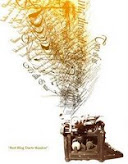
You will need two sessions to complete this project.
Supplies Needed:
Poster board shape tracers
Pencil
Foam board or heavy paper in the color of your background
Craft paint
Paintbrush
Water
 The fun thing about this project is that two people will use the same shapes to create completely different paintings. My aunt and I both wanted to use all the shapes available so we could show this to you. You can pick which shapes you want to include in your painting and which you want to leave out.
The fun thing about this project is that two people will use the same shapes to create completely different paintings. My aunt and I both wanted to use all the shapes available so we could show this to you. You can pick which shapes you want to include in your painting and which you want to leave out. Choose a sheet of paper or a piece of foam board in the color you’d like your background to be. You could also paint a solid color over the entire paper. Trust me; it’s a pain to paint the background after you’ve traced your image onto your paper. If you decide to paint your background, remember to let it dry before you go on.
Choose a sheet of paper or a piece of foam board in the color you’d like your background to be. You could also paint a solid color over the entire paper. Trust me; it’s a pain to paint the background after you’ve traced your image onto your paper. If you decide to paint your background, remember to let it dry before you go on.Arrange the tracers into a picture on your paper. Move them around until you create an image you like. This seems like it would be difficult, but the shapes will form into pictures if you move them around enough. Remember, the color of the tracers doesn’t matter because you’re going to paint later.

 When you’re happy with the layout, trace each shape with your pencil. This is the trickiest part of this project because the shapes can move if you aren’t careful. Take your time.
When you’re happy with the layout, trace each shape with your pencil. This is the trickiest part of this project because the shapes can move if you aren’t careful. Take your time. This is a good place to take a break if you need one.
This is a good place to take a break if you need one.The final step is to paint. At this point, you’re basically filling in a coloring book page. It’s much more satisfying, though, because you drew the outline yourself.


Allow your painting to dry and then compare it to the paintings your friends made using the same group of shape tracers. What similarities and differences do you notice?
Return to main page.




 The completed Confederate Memorial Carving at Stone Mountain, Georgia shows Confederate General Robert E. Lee, Confederate President Jefferson Davis, and Confederate General Stonewall Jackson, all on horseback. The carving is about the size of 3 football fields. It took 56 years and 3 sculptors to complete. None of what you see today was Gutzon Borglum’s work.
The completed Confederate Memorial Carving at Stone Mountain, Georgia shows Confederate General Robert E. Lee, Confederate President Jefferson Davis, and Confederate General Stonewall Jackson, all on horseback. The carving is about the size of 3 football fields. It took 56 years and 3 sculptors to complete. None of what you see today was Gutzon Borglum’s work. Borglum ran into a problem when it was time to begin work: How would he sketch his idea onto the mountain? He thought about this problem for a long time before developing a sort of overhead projector that could enlarge his sketch and project it onto the mountain. This projector was much larger than the ones teachers use in the classroom but worked in a similar way.
Borglum ran into a problem when it was time to begin work: How would he sketch his idea onto the mountain? He thought about this problem for a long time before developing a sort of overhead projector that could enlarge his sketch and project it onto the mountain. This projector was much larger than the ones teachers use in the classroom but worked in a similar way. Mount Rushmore is located in the Black Hills in South Dakota:
Mount Rushmore is located in the Black Hills in South Dakota: About 2 million people visit each year and I can understand why. The massive faces of former presidents George Washington, Thomas Jefferson, Theodore Roosevelt, and Abraham Lincoln have been carved into the mountainside in stunning detail that’s impossible to portray in a photograph. It’s tough to believe that the monument was meant to be much larger.
About 2 million people visit each year and I can understand why. The massive faces of former presidents George Washington, Thomas Jefferson, Theodore Roosevelt, and Abraham Lincoln have been carved into the mountainside in stunning detail that’s impossible to portray in a photograph. It’s tough to believe that the monument was meant to be much larger. It wasn’t easy to carve the faces into the solid granite mountain. The men had to blast away a lot of the rock using dynamite before they could begin to carve. They used a jackhammer, like the one below, to make holes for the dynamite.
It wasn’t easy to carve the faces into the solid granite mountain. The men had to blast away a lot of the rock using dynamite before they could begin to carve. They used a jackhammer, like the one below, to make holes for the dynamite. 
 Dynamite was also used to erase mistakes from the mountain. Borglum originally settled on a design for the mountain that put Thomas Jefferson to the left of George Washington. When he discovered that the rock on that side of George Washington wasn’t strong enough to support the sculpture, the men blasted Jefferson off the mountain and began again on the other side of Washington.
Dynamite was also used to erase mistakes from the mountain. Borglum originally settled on a design for the mountain that put Thomas Jefferson to the left of George Washington. When he discovered that the rock on that side of George Washington wasn’t strong enough to support the sculpture, the men blasted Jefferson off the mountain and began again on the other side of Washington. This process took 14 years; carving began in October 1927 and ended in October 1941.
This process took 14 years; carving began in October 1927 and ended in October 1941. In March 1941, Borglum died and his son took over the project. The United States became involved in World War II and Congress decided that we could not spend any more money on Mount Rushmore. It declared the mountain a finished piece of art.
In March 1941, Borglum died and his son took over the project. The United States became involved in World War II and Congress decided that we could not spend any more money on Mount Rushmore. It declared the mountain a finished piece of art. I’m sure many of you have seen this project done elsewhere, but I love it. It’s quick and simple, and each child’s art piece is unique and creative. I like it as a beginning of the year project, especially if you’re studying fingerprints and fingerprinting. In Maryland, fingerprinting is often the first science unit that third graders complete, so hopefully this post is timely.
I’m sure many of you have seen this project done elsewhere, but I love it. It’s quick and simple, and each child’s art piece is unique and creative. I like it as a beginning of the year project, especially if you’re studying fingerprints and fingerprinting. In Maryland, fingerprinting is often the first science unit that third graders complete, so hopefully this post is timely. Choose an ink color. This will be the body of your thumbprint animal. Press your thumb into the ink pad and then onto the center of your cardstock square. You should push your thumb straight down and then lift it straight up so your thumbprint doesn’t smear.
Choose an ink color. This will be the body of your thumbprint animal. Press your thumb into the ink pad and then onto the center of your cardstock square. You should push your thumb straight down and then lift it straight up so your thumbprint doesn’t smear. Decide what animal you’d like to create. I made a butterfly, a frog, a spider, and a rabbit. You might choose to make a chick, a fly, or an animal from your own imagination. Draw the face and details with a fine-tipped marker.
Decide what animal you’d like to create. I made a butterfly, a frog, a spider, and a rabbit. You might choose to make a chick, a fly, or an animal from your own imagination. Draw the face and details with a fine-tipped marker. Sign your name at the bottom of your square. Frame and enjoy!
Sign your name at the bottom of your square. Frame and enjoy!


